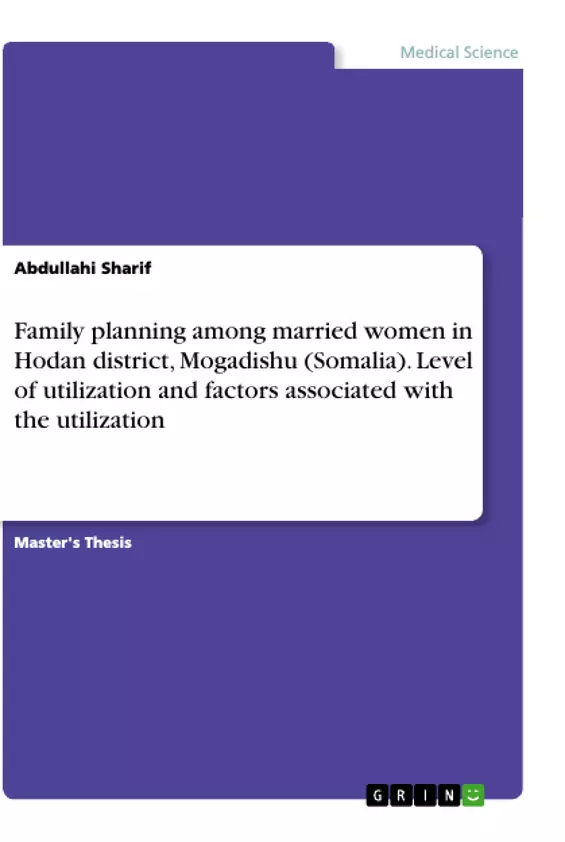The objective of this study was to assess the level of utilization and factors associated with the utilization of family planning among married women of reproductive age (15-49 years) in Hodan district, Mogadishu - Somalia.
Nearly all (99%) of maternal death occur in the developing countries. However, family planning (FP) could prevent as many as one in every three maternal deaths by allowing women to delay motherhood, space birth, avoid unintended pregnancies and abortion and stop childbearing when they reached their desired family size.
East Africa is a region with increasing utilization of family planning methods among married women of fertile age (CDC, 2016). Yet, Somalia is the lowest for contraceptive utilization among other countries of the region due to various factors which need to be scientifically investigated.
A community based cross-sectional study design was conducted among currently married women of reproductive age (15-49).The data were collected from 228 study subjects by face to face interview technique by using structured questionnaire. Univariate analysis was done to determine frequencies of utilization of family planning services. Using odds ratios, bivariate analysis was then done to assess factors associated with the utilization of family planning services among married women in Hodan District, Mogadishu – Somalia.
Inhaltsverzeichnis (Table of Contents)
- CHAPTER ONE: INTRODUCTION..
- 1.2 Statement of the problem
- 1.3. General objective of the study......
- 1.4 Specific objectives.........
- 1.5. Research questions.
- 1.6 Significance of the study.
- 1.7 scope of the study..
- 1.8 Operational Definition
- 1.9 Conceptual framework.
- CHAPTER TWO: BACKGROUND.
- CHAPTER THREE: LIT ERATURE REVIEW
- 3.0 INTRODUCTION..
- 3.1 HEALTH SYSTEM FACTORS AND UTILIZATION OF FAMILY PLANNING\nSERVICES..
- 3.1.1 Availability of family planning services.
- 3.1.2 Quality of family planning services offered
- 3.1.3 Integration of family planning services with other services
- 3.2 CULTURAL FACTORS AND UTILIZATION OF FAMILY PLANNING SERVICES
- 3.3 SOCIO-DEMOGRPHIC FACTORS AND UTILIZATION OF FAMILY PLANNING\nSERVICES.
- 3.4 Summary
- CHAPTER FOUR: METHODOLOGY
- 4.0 Introduction.
- 4.1 Research Design..........\li>
- 4.2 Study area.
- 4.3 Target population
- 4.4 Sample Size.
- 4.5 Sampling Procedure.
- 4.6 Exclusion and Inclusion Criteria.
- 4.6.1 Inclusion Criteria..
- 4.6.2 Exclusion Criteria......
- 4.7 Study Variables
- 4.8 Data collection methods and instruments.......
- 4.9 Validity and Reliability of the study instruments.
- 4.9.1 Validity.
- 4.10 Data Gathering Procedures ......
- 4.11 Data processing and analysis...
- 4.12 Ethical consideration .......
- 4.13 Limitations.
- CHAPTER FIVE: RESULTS.
- 5.0 Introduction .
- 5.1 Demographic characteristics of the respondents .....
- 5.2 Prevalence of family planning services.........
- 5.3 Health System Factors......
- 5.4 Cultural factors.......
- CHAPTER SIX: DISCUSSION
- 6.1 Discussion
Zielsetzung und Themenschwerpunkte (Objectives and Key Themes)
This study aims to investigate the factors influencing the utilization of family planning services in Hodan District, Somalia. The research explores the interplay of various factors, including health system factors, cultural influences, and socio-demographic characteristics, to determine their impact on the adoption and use of family planning methods by residents of the district.
- The impact of health system factors, such as availability, accessibility, and quality of family planning services, on utilization.
- The influence of cultural factors, including societal norms, religious beliefs, and spousal attitudes, on family planning practices.
- The role of socio-demographic characteristics, including age, education level, and knowledge about family planning methods, in shaping utilization patterns.
- The identification of potential barriers and facilitators to accessing and utilizing family planning services in the study area.
- The exploration of strategies and interventions that can enhance the uptake and utilization of family planning services in Hodan District.
Zusammenfassung der Kapitel (Chapter Summaries)
Chapter One provides an introduction to the study, outlining the problem statement, objectives, research questions, significance, scope, operational definitions, and the conceptual framework. Chapter Two delves into the background of family planning in Somalia, highlighting the context and factors influencing its utilization. Chapter Three presents a comprehensive literature review, examining existing research on the determinants of family planning services utilization, including health system factors, cultural factors, and socio-demographic characteristics. Chapter Four outlines the research methodology employed in the study, including the research design, study area, target population, sample size, sampling procedure, exclusion and inclusion criteria, data collection methods and instruments, validity and reliability of instruments, data gathering procedures, data processing and analysis, ethical considerations, and limitations. Chapter Five presents the findings of the study, analyzing the demographic characteristics of the respondents, prevalence of family planning services, and the influence of health system, cultural, and socio-demographic factors on utilization. Chapter Six discusses the implications of the findings, drawing connections with existing literature and highlighting the significance of the results within the context of family planning in Somalia.
Schlüsselwörter (Keywords)
The study focuses on the determinants of family planning services utilization in Hodan District, Somalia, examining the influence of health system factors, cultural factors, and socio-demographic characteristics. Key concepts include family planning, utilization, access, accessibility, availability, quality, cultural influences, socio-demographic characteristics, health system factors, barriers, facilitators, and interventions.
- Arbeit zitieren
- Abdullahi Sharif (Autor:in), 2019, Family planning among married women in Hodan district, Mogadishu (Somalia). Level of utilization and factors associated with the utilization, München, GRIN Verlag, https://www.grin.com/document/502232



